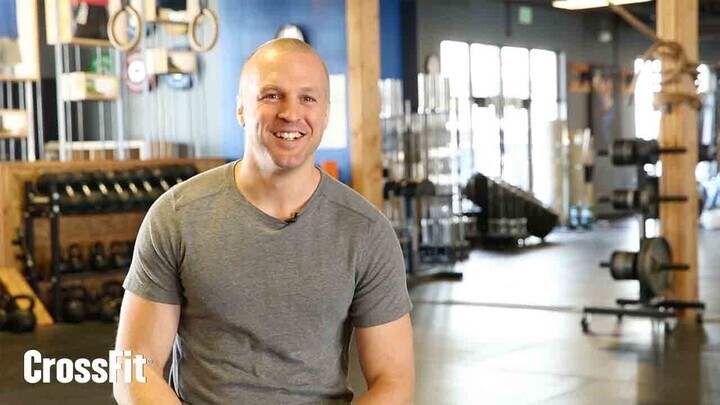Question: Do members need to be able to do one strict pull-up before we teach them how to kip?
As you may recall from your Level 1 Certificate Course, CrossFit advises athletes to master a strict pull-up before attempting kipping pull-ups. This is to establish a solid foundation of shoulder stability and strength. However, it’s not uncommon to find members in your affiliate who have been doing kipping pull-ups for years yet struggle with a single strict pull-up.
How does that happen?
It often happens because the kipping pull-up is the default pull-up in CrossFit workouts. Because kipping pull-ups are used to increase work accomplishment and power output during conditioning workouts, many people can get away with only doing kipping pull-ups. On the rare occasion strict pull-ups are part of the WOD, these athletes can utilize a pull-up variation to achieve the stimulus. However, be aware that using the same movement modification with the same difficulty level will do little to develop the capacity to do strict pull-ups. For example, doing band-assisted pull-ups every time might not get you closer to your goal. Ensure you are rotating your scaling options to aid with development. (Here’s a great post on pull-up scaling options.)
If your gym’s goal, or that of some of your athletes, is to perform a decent set of strict pull-ups, how do you guide them there? Your commitment to teach, coach, and assess your athletes is the answer. And, of course, their nutrition.
TEACH
Nearly 20 muscles are involved in executing a strict pull-up. The primary movers are the upper back muscles (e.g., latissimus dorsi). The secondary movers are the elbow flexor muscles (e.g., biceps). Finally, the trunk muscles (e.g., abs, obliques, erectors) stabilize the midline to allow for efficient power transfer.
Deficiency in any one muscle can prevent progress toward the goal.
In “Stand Before You Walk: Gymnastics Foundations,” the authors stress the following:
“Those who do not possess the foundational building blocks of any skill set will often quickly meet a ceiling that limits performance. Here’s an all-too-common statement: “I can only string together one or two muscle-ups before I lose it.” Without question, this problem is rooted in inconsistent form and deficient strength beyond the first rep. Progress stalls because the foundational skills aren’t in place, and deficiencies at low volume remove the possibility of higher volume.”
So, although focusing on strict strength may be frustrating, it helps athletes create a solid base, preventing early performance plateaus and allowing for better progress in the future, not just in the pull-up domain but for many movements. Once they understand this, they may be more motivated to spend time outside class to develop the strength needed to perform the movement.
COACH
As their coach, you can offer several ways for them to increase capacity and develop the strength necessary to do strict pull-ups by focusing on upper-body pulling exercises.
There are many progressions and scaling options an athlete can perform to increase strength, including,
- Partner assisted pull-ups
- Band-assisted pull-ups
- Toe-nail spotted pull-ups
- Lat pull-downs with a band or on a machine
- Chin-over-the-bar holds and segmented deficit holds
- Scap pull-ups
- Ring rows
- Banded face pulls
- Bat wings
- Chinese rows
- Single-arm landmine row
- Hand-over-hand rope pulls
- Double kettlebell bent-over rows
- Double kettlebell alternating gorilla row
- Single-arm kettlebell Romanian deadlift
There are various ways athletes can incorporate pulling drills into their program, but you might also consider giving them a simple-to-follow program — like this one for the muscle-up — they can reference as they work toward their first strict pull-up.
ASSESS
If you know athletes who are working hard outside class to develop capacity in strict movements, be sure to check in with them, acknowledge their efforts, and celebrate their wins.
- If they’re stuck and not making progress, spend a few minutes watching their movement and offer some tips.
- If the extra work they’re putting in drains them so much they fall short of their capacity during regular classes, talk to them about ways to add extra work without sacrificing energy and gains.
- Offer to connect them with others working on similar goals.
- Offer a workshop on getting your first strict pull-up, or, as mentioned above, design a do-it-yourself program you can gift to your members or offer for purchase.
Getting their first strict pull-up (or handstand push-up, muscle-up, dip, etc.) is a significant accomplishment for many people, and it often unlocks a new level of drive, commitment, and confidence when it happens. Help them get there, and they’ll never forget it.
Have a question for a coach? Please submit that here.
Want to get better at gymnastics movements? Register for our upcoming webinar on October 2 with D1 gymnast and 3x Games athlete Pamela Gagnon to learn how to implement strength and gymnastics skills to improve your performance inside and outside the gym.
About the Author

Eric O’Connor is a Content Developer and Seminar Staff Flowmaster for CrossFit’s Education Department and the co-creator of the former CrossFit Competitor’s Course. He has led over 400 seminars and has over a decade of experience coaching at a CrossFit affiliate. He is a Certified CrossFit Coach (CF-L4), a former Division 1 collegiate wrestler, and a former CrossFit Games athlete.
Ask a Coach: Do Members Need to Be Able to Do One Strict Pull-Up Before We Teach Them How to Kip?